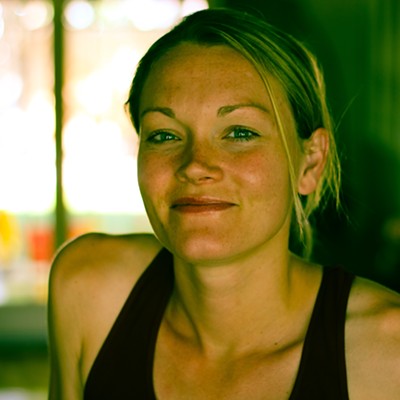You can find art all over town — not just on gallery walls. In this series, we look at some of the local artists who serve up their work in coffeehouses and other non-gallery outposts around town.
Rosane Volchan O’Conor grew up in Rio de Janeiro, Brazil, and studied music and biology at the Universidade Federal do Rio de Janeiro — which begins to explain her current installation at Denver International Airport, on display in the Jeppesen Terminal through July.
The colorful, chaotic installation, known as "Acúmulo” – translated from Portuguese to “growth by continued additions” – depicts a loosely interpreted microbiological habitat. In her biomorphic creation, O’Conor has created a world of paramecium, spores and neurons from an eclectic mix of materials, including neon lights, ceramics, wood, metal and found objects: loofah sponges from Brazil, porcelain-dipped Spanish moss from Houston, even some industrial materials from DIA’s recycling collection. “The installation borrows the vocabulary of my multi-layered monoprints, with scribbled lines turned to contorted wire and organic shapes to plaster abstractions,” explains O'Conor.
In addition to her science studies in college, her DIA installation was also influenced by conversations with her older sister, Eliane, a neurophysiologist who’s always up for, as O’Conor puts it, “insightful discussions about the microbiological world and neuroscience."
The sculptor is inspired by nature, too. “I like to explore the interconnection between objects and the notion of time passage,” she explains.
“The process of installation starts with drawings on the wall and floor, created by projecting enlarged images taken from the monoprints on paper,” O’Conor adds. “There are no predesigned plans.” Once the stage is set, various elements are placed in a series of “additive creative steps,” she notes.
To create one of these pieces, over the course of about a week to nine days the artist toils with a wonderfully bizarre supply of found objects – “industrial detritus, organic material" – and pieces created and accumulated over time: welded metal wire, torch-bended glass, sculpted acrylic shapes, mylar, porcelain-dipped objects, glazed hand-built sculptures, cement shapes and free-hand graphite wall drawings.
“By combining these objects — created or found at different times in my life — my installations become autobiographical, a self-portrait,” O’Conor says. The end result is a comprehensive and immersive environment that viewers are invited to actually step inside. “What I consider unique about my work is the fact that I follow my interest in experimenting with new materials and accumulating elements from different media,” she continues.
This refers back to her past. “My mother was one of the directors of the Saturday art-school program at my elementary school,” O’Conor explains. “The Saturday school hired a group of progressive artists/teachers who believed in the process of experimentation." Budding young artists like O’Conor were free to dabble in all sorts of mediums on Saturdays — from ceramics and finger paint to woodworking and puppet making. “I believe this early experience with freedom of creation left an imprint on me,” she says.
Many of her three-dimensional environments reflect her interest in music composition. “Encouraged by my father, an amateur violinist, I started playing the recorder at age five, then transitioned to the flute,” O’Conor explains. She specialized in classical music as well as Brazilian choro — and even performed professionally with an ensemble in her twenties.
O’Conor studied music at the Brussels Royal Conservatoire while taking art classes at the Academie d'Art Auderghem in Brussels. “It was there that I met my American husband, Peter, and had three kids,” the artist explains. She moved to Houston with her family in the 1990s, and found her way to Boulder five years ago.
O’Conor is represented by Goodwin Fine Art, and has shown her installations in Brazil, Texas and at local venues, including the Boulder Museum of Contemporary Art and Metropolitan State University of Denver’s Center for Visual Arts. In 2017, O’Conor’s “Archaea” will be featured at the Yellowstone Art Museum in Billings, Montana. For more information on the artist, visit O’Conor’s website and check out her Facebook page.
[
{
"name": "Air - MediumRectangle - Inline Content - Mobile Display Size",
"component": "12017618",
"insertPoint": "2",
"requiredCountToDisplay": "2"
},{
"name": "Editor Picks",
"component": "17242653",
"insertPoint": "4",
"requiredCountToDisplay": "1"
},{
"name": "Inline Links",
"component": "18838239",
"insertPoint": "8th",
"startingPoint": 8,
"requiredCountToDisplay": "7",
"maxInsertions": 25
},{
"name": "Air - MediumRectangle - Combo - Inline Content",
"component": "17261320",
"insertPoint": "8th",
"startingPoint": 8,
"requiredCountToDisplay": "7",
"maxInsertions": 25
},{
"name": "Inline Links",
"component": "18838239",
"insertPoint": "8th",
"startingPoint": 12,
"requiredCountToDisplay": "11",
"maxInsertions": 25
},{
"name": "Air - Leaderboard Tower - Combo - Inline Content",
"component": "17261321",
"insertPoint": "8th",
"startingPoint": 12,
"requiredCountToDisplay": "11",
"maxInsertions": 25
}
]











